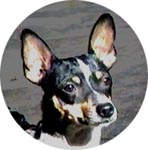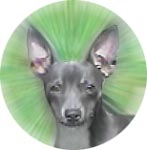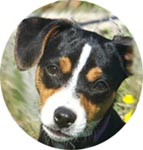|
RAT TERRIER
BREED STANDARDS
Accepted
December 1, 1998
The Rat Terrier
not only comes in 3 sizes but also two body types. Rats that have a square,
long leg look are shown as Class A. Rat Terriers that have a shorter
leg length in proportion to body are shown as Class B. The following
standards will apply to both classes with the exception of the difference
in body to leg length (shown below) also see (Body Standards). These are
two separate and unique body styles for the Rat Terrier and to keep them
this way, it is recommended that they never be bred together. They have
been with the Rat since their American existence, and there are no differences
other than body style. Both Class A and B dogs share all of the same wonderful
rat terrier traits. To deny either style would be to taint the existence
of the breed.
|
CLASS A 10:10:9
RATIO
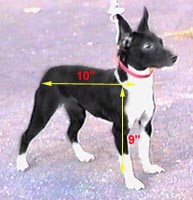
|
CLASS B 10:8:7
RATIO
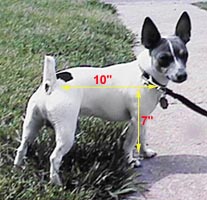 |
- GENERAL APPEARANCE
When you first meet
a Rat, his smooth lines and muscles are immediately apparent and his face
shows all the familiarity of a dog you've known all your life. Only half
the story is told, for under that lies capabilities that are far beyond
what they first appear to be. Whether it is a Toy, Mini, or Standard Rat
Terrier, from the first look, you know that you are viewing a true athlete.
They possess a muscular body with extreme agility, astounding ability and
great endurance. Rats are never fragile and should posses great tone. He
is balanced, clean, crisp and beautiful. His coat is short, smooth, sleek
and shines. From their appearance you would never know that they are serious
rat and vermin dogs (100 times better than any cat). Being quick and clean
with the kill. They are sturdy, have well balanced movement and are in
wonderful proportion. Their tail is docked and held in an upright
position when alert.
They are an attractive
dog with a bouncy yet sophisticated and concerned attitude with sparkling
sincere eyes. The Rat Terrier has the expression of being curiously concerned,
somewhat worried and seriously inquisitive.
These pictures show the classic
Rat Terrier Expression
TEMPERAMENT:
He makes an excellent
guard, companion, and house dog and is good with children. His ease of
training and innate instincts makes the Rats unsurpassed hunters and ratters.
They don't really mind getting their feet wet and many enjoy swimming,
hiking very content playing with their own toys. He hides nothing being
confident around other animals large and small. The Rat is a dog that commands
respect but absolutely adores his family. He is eager to please bonding,
sociable and sensitive. It is never a yippee type of dog but quick to sound
an alarm when he senses something new.
Rat Terriers are enthusiast upon his peoples
arrival showering them with kisses, affection, love and loyalty. He is
basically pleasant and easy to get along with. At ease at home relaxing
with his master doing well with the family, hardy enough to with stand
a child's roughest play.
.
CHARACTER:
The Rat Terrier
retains his true terrier heritage by being a superb ratter. He is gritty,
feisty and tough yet never out of control, quick, alert, agile and fleet.
They will make strong eye contact with you, cocking their head trying to
understand, willing to do what ever you ask of them. But clowning around,
soliciting play and sleeping by their master with one eye open, always
ready, is one of their specialties. Although they prefer to not stray far
from their master's side, they sometimes enjoy the solitude of their own
space. Rats are highly adaptable to a variety of climates and environments,
from apartments to farms and from Alaska to Florida. While active outdoors
he makes a wonderful house pet, companion and watchdog. Females make excellent
mothers, hardy, healthy rugged and clean.
HEAD
MUZZLE:
Medium long,
muscular cheeks, wedge shaped and blunted, tapered but not snippy. Distance
approximately equal to skull. Moderate stop. Fault: to sharp of
a stop like seen in the Chihuahua breed or too short of a muzzle.
STOP:
Medium, tapered,
not sharp.
SKULL:
Slightly rounded
with moderate width between the ears. Fault: apple or dome head. |
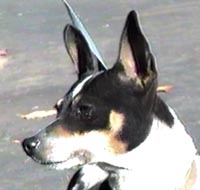 - Proper head for a Rat Terrier
|
EARS:
Wedge shaped
placed well up on the side of the head. Preferred Erect, Acceptable Semi
Erect/Tipped and Button/Folded. Fault: spaced to far apart,
one up one down, round and bat like or hound.
NOSE:
Nose should be
solid in color. Acceptable colors, Black or slate, brown or red shaded
according to coat color. Fault: pink or pink spotted, snow nose.
BITE:
Scissors or level.
The top teeth should not extend more than 1/16 of an inch beyond the lower
teeth. Fault: overshot that extends more than 1/16 of an inch and
is to be penalized by the degree of severity. Extreme fault: undershot
bite wry mouth, retained baby teeth in adult dogs.
.
LIPS:
Should be tight
and smooth, predominately black or in accordance with coat color.
Fault:
lips that overhang hiding the lower jaw or sagging flews.
NECK
Moderately long, slightly arched, widening
into the shoulder, strong and muscular in appearance giving good support
to the head. There should be no hint of throatiness. Fault:
straight or thin lacking muscle.
FOREQUARTERS
The forequarters act as a unit on the dog.
When one part is not in unison or proportion with the others it tends to
throw off the entire forequarters.SHOULDERS:
Sloping and well
arched with good layback set at a 45% angle. The
length from the elbow to the top of the shoulder should be approximately
the same length as the distance from the elbow to
the ground. The scapula is equal in length to the upper arm.
CHEST:
Fairly deep and
well ribbed. When viewed from the front, moderately
wide between the shoulders allowing straight placement
of the legs. When viewed from the side the chest lies
even or extends just beyond the shoulders. The brisket descends
to or just above the elbow. Fault: to narrow, excessive
barrel chest or one that lacks depth in brisket giving too
leggy of an appearance.
FRONT LEGS:
Straight with
ample bone and proportion placed well under the body. Feet pointed forward
and at the same distance apart from between the elbows and at the feet.
Forearm and upper arm are of approx. equal distance, forearm being slightly
longer
Fault: turned in or out, bow legged.
ELBOW:
Free from the
body, held close and perpendicular. When viewed from the front, elbows
should not be visible.Fault: turning neither in or out, bow legged.
FRONT FEET:
Oval, compact,
well arched, middle two toes longer than the others. Well up on pastern
showing a very slight angle towards the ground. Front and rear
dewclaws are normally removed. This cuts down injuries to the working dogs
feet. If front dewclaws are present they are not to be faulted.
Fault: feet turned either in or
out, splayed. Down on
pastern or knuckled over. Rear dewclaws.
|

This dog shows proper leg
proportion. Legs are
straight with equal distance. |
BODY
The body length of both classes is
the same, it is the length of leg that differs.
CLASS A - Height is approximately
the same to length, measured from ground to withers and from point of shoulder
to rump, length not to exceed 1 1/2" from height. For example if your dog
is 12 " long, it should measure no less than 10 1/2" in height.
Fault: excessive barrel chest or
round body.
.
CLASS B - the shorter leg
type, body length not to exceed 3 " or less than 1 3/4" from height.
For example if your dog measures 12" in length, its height should fall
between 9"- 10 1/4". Fault: excessive barrel chest or round body.
BACK: (Topline)
Level, straight
and strong. Tail set high coming right off the back.
.
BRISKET: (chest rib cage)
Set fairly deep
giving ample lung space, lying even or just above the elbow. Ribs are well
sprung but do not interfere with leg placement.
Fault: to shallow or too wide causing
bowing or turning in or out of legs.
TUCK UP:
The bottom line
has moderate tuck up into the loins (waist). Fault:
Extreme tuck up as seen in the Greyhound breed causing the backto roach
or lack of tuck up giving a straight underline appearance.
HINDQUARTERS
BACK LEGS:
The hindquarters
are moderately angulated, set in alignment with front legs. Strong and
muscular in thigh. Slight angulation in hock and well let down. Stifles
turned neither in or out. Fault:
cow hocked, straight stifles or bowed.
THIGHS:
Upper and lower thighs are approximately
equal.
HOCK: (Pastern)
Turned neither
in or out when viewed from the rear and
has a slight inward angulation when viewed
from the side.
REAR FEET:
Oval and compact, more
Hare like than Cat like with the middle two toes being longer. Dewclaws
should be removed before the dog is one week of age.
TAIL:
Set high and
carried erect when the dog is alert. Tails should be docked as a puppy
before one week of age. Leave approximately 3/4 of an inch on the puppy,
which as adults produces a tail of approx. 2-3". Fault: full
tail, or no tail (exception; a dog born with a natural bob is not to be
penalized regardless of tail length)
.
MOVEMENT (GAIT)
Smooth flowing legs
moving straight, agile with rear legs in unison with front legs. Good conformation
and proper structure determine correct movement. If any body part is in
misalignment it will affect the soundness of the dogs gait. Faults are
given to the part of the body structure that causes incorrect movement.
.
COAT:
Short, smooth, thick and dense with lots of
luster and shine.
COLOR:
ACCEPTABLE COLORS: Black,
blue, red, apricot, lemon, charcoal, chocolate or liver. Browns:(Sable,
fawn, tan) Chocolate and liver must have a chocolate, liver or red nose.
MARKINGS:
With white, w/ tan, w/ white and tan
PATTERNS:
Tri, Piebald (spots of color), Bi (no
wht), Solid, Ticking
WEIGHT AND HEIGHT:
Toys 10lbs. or less (Tots under 5lbs.)
Height - not to exceed 12 inches
Mini over 10lbs up to 18lbs. Height
- not to exceed 15 inches
Standard over 18lbs up to 28lbs.
Height - not to exceed 18 inches
(measured from the withers to the ground)
Click Here For Photos of the Sizes
DISQUALIFICATIONS:
A dog that cannot be brought under control.
Monorchid and Cryptorchid, pure white, brindle or merle color.
DIAGRAM OF PARTS OF A DOG
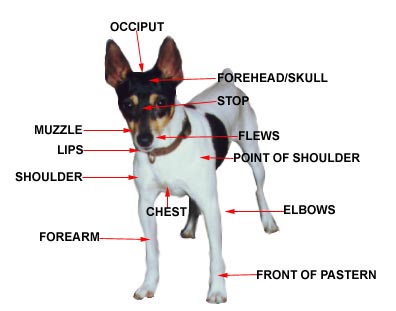
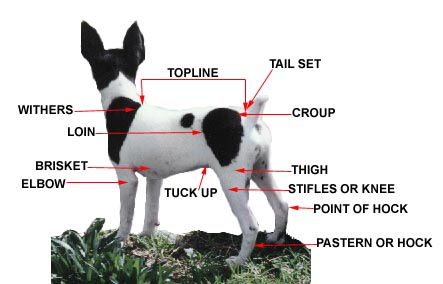
|


